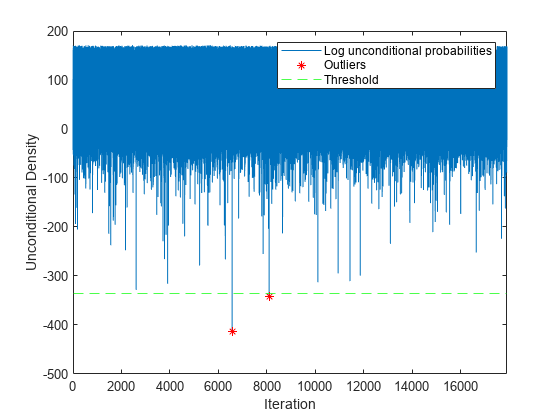logp
説明
例
fitcnb を使用して単純ベイズ分類モデルに学習させ、それをインクリメンタル学習器に変換してから、そのインクリメンタル モデルを使用してストリーミング データの外れ値を検出します。
データの読み込みと前処理
人の行動のデータ セットを読み込みます。データをランダムにシャッフルします。
load humanactivity rng(1); % For reproducibility n = numel(actid); idx = randsample(n,n); X = feat(idx,:); Y = actid(idx);
データ セットの詳細については、コマンド ラインで Description を入力してください。
単純ベイズ分類モデルの学習
単純ベイズ分類モデルをデータの約 25% の無作為標本に当てはめます。
idxtt = randsample([true false false false],n,true); TTMdl = fitcnb(X(idxtt,:),Y(idxtt))
TTMdl =
ClassificationNaiveBayes
ResponseName: 'Y'
CategoricalPredictors: []
ClassNames: [1 2 3 4 5]
ScoreTransform: 'none'
NumObservations: 6167
DistributionNames: {1×60 cell}
DistributionParameters: {5×60 cell}
Properties, Methods
TTMdl は、従来式の学習済みモデルを表す ClassificationNaiveBayes モデル オブジェクトです。
学習済みモデルの変換
従来式の学習済み分類モデルをインクリメンタル学習用の単純ベイズ分類モデルに変換します。
IncrementalMdl = incrementalLearner(TTMdl)
IncrementalMdl =
incrementalClassificationNaiveBayes
IsWarm: 1
Metrics: [1×2 table]
ClassNames: [1 2 3 4 5]
ScoreTransform: 'none'
DistributionNames: {1×60 cell}
DistributionParameters: {5×60 cell}
Properties, Methods
IncrementalMdl は incrementalClassificationNaiveBayes オブジェクトです。IncrementalMdl はインクリメンタル学習用の単純ベイズ分類モデルを表し、パラメーター値は TTMdl のパラメーターと同じです。
外れ値の検出
従来式の学習済みモデルと学習データを使用して、外れ値の条件なし密度のしきい値を調べます。外れ値は、密度がしきい値より小さいストリーミング データの観測値です。
ttlp = logp(TTMdl,X(idxtt,:)); [~,lower] = isoutlier(ttlp)
lower = -336.0424
残りのデータでこれらの外れ値を検出します。観測値を一度に 1 個ずつ処理して、データ ストリームをシミュレートします。各反復で logp を呼び出して観測値の対数条件なし確率密度を計算し、それぞれの値を保存します。
% Preallocation idxil = ~idxtt; nil = sum(idxil); numObsPerChunk = 1; nchunk = floor(nil/numObsPerChunk); lp = zeros(nchunk,1); iso = false(nchunk,1); Xil = X(idxil,:); Yil = Y(idxil); % Incremental processing for j = 1:nchunk ibegin = min(nil,numObsPerChunk*(j-1) + 1); iend = min(nil,numObsPerChunk*j); idx = ibegin:iend; lp(j) = logp(IncrementalMdl,Xil(idx,:)); iso(j) = lp(j) < lower; end
ストリーミング データの対数条件なし確率密度をプロットします。外れ値を特定します。
figure; h1 = plot(lp); hold on x = 1:nchunk; h2 = plot(x(iso),lp(iso),'r*'); h3 = yline(lower,'g--'); xlim([0 nchunk]); ylabel('Unconditional Density') xlabel('Iteration') legend([h1 h2 h3],["Log unconditional probabilities" "Outliers" "Threshold"]) hold off

入力引数
インクリメンタル学習用の単純ベイズ分類モデル。incrementalClassificationNaiveBayes モデル オブジェクトとして指定します。Mdl は、直接作成することも、サポートされている従来式の学習済み機械学習モデルを関数 incrementalLearner によって変換して作成することもできます。詳細については、対応するリファレンス ページを参照してください。
Mdl は、観測値のバッチで対数条件付き確率密度を計算するように構成しなければなりません。
Mdlが従来式の学習済みモデルから変換される場合、いかなる修正も行うことなく対数条件付き確率を計算できます。それ以外の場合、
Mdl.DistributionParametersは、列数がMdl.NumPredictors> 0 で行数が 1 以上の cell 行列でなければなりません。各行はMdl.ClassNamesの各クラス名に対応します。
対数条件付き確率密度を計算するための予測子データのバッチ。n 行 Mdl.NumPredictors 列の浮動小数点行列として指定します。
j = 1 ~ n のそれぞれについて、X( に j,:)NaN が少なくとも 1 つ含まれていると、lp( は j)NaN になります。
データ型: single | double
出力引数
詳細
予測子の "条件なし確率密度" はクラスで重視されない密度の分布です。
つまり、条件なし確率密度は次のようになります。
ここで、π(Y = k) はクラスの事前確率です。クラス (P(X1,..,XP|y = k)) に対するデータの条件付き分布およびクラスの事前確率分布が、学習オプションになります (つまり、分類器を学習させるときにそれらを指定します)。
クラスの "事前確率" は、母集団内でそのクラスの観測値が出現すると考えられる相対頻度です。
バージョン履歴
R2021a で導入
MATLAB Command
You clicked a link that corresponds to this MATLAB command:
Run the command by entering it in the MATLAB Command Window. Web browsers do not support MATLAB commands.
Web サイトの選択
Web サイトを選択すると、翻訳されたコンテンツにアクセスし、地域のイベントやサービスを確認できます。現在の位置情報に基づき、次のサイトの選択を推奨します:
また、以下のリストから Web サイトを選択することもできます。
最適なサイトパフォーマンスの取得方法
中国のサイト (中国語または英語) を選択することで、最適なサイトパフォーマンスが得られます。その他の国の MathWorks のサイトは、お客様の地域からのアクセスが最適化されていません。
南北アメリカ
- América Latina (Español)
- Canada (English)
- United States (English)
ヨーロッパ
- Belgium (English)
- Denmark (English)
- Deutschland (Deutsch)
- España (Español)
- Finland (English)
- France (Français)
- Ireland (English)
- Italia (Italiano)
- Luxembourg (English)
- Netherlands (English)
- Norway (English)
- Österreich (Deutsch)
- Portugal (English)
- Sweden (English)
- Switzerland
- United Kingdom (English)